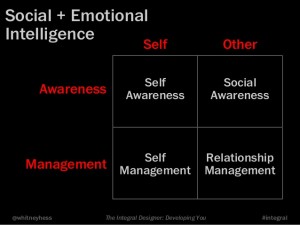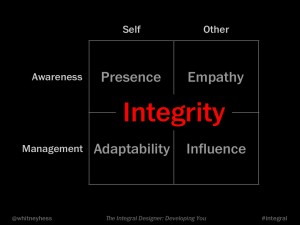Sword & Sharpie is all about helping designers improve their soft skills to make a bigger impact on the world and grow their influence. To tackle that mission, I’m working on a soft skills framework specifically for UX designers. I’m gathering research and input from the best and brightest, and I can’t wait to share it all with you.
To get started, I reached out through email and tweets to some of my design heroes on what they thought were the most critical soft skills for success as a UX designer. I emailed and tweeted as well as looked up existing brilliant work, when possible.
Here’s what these awesome designers had to say—the most important soft skills for upping your design game.
Presentation
How you describe your ideas, how you paint a picture of your vision, how well you keep your audience engaged and understanding—all of these are critical to a designer’s success. The medium is the message. This skill is particularly important because presenting ideas is often how you get your ideas into other people’s heads. This is true if you’re presenting informally to your close team members, or formally to a large group, or anywhere in between. If you’re the lucky member of a team where ideas are generated and owned together, presentation is critical to communicating your team’s ideas to other stakeholders. It’s also how you build shared understanding within the team.
Jared Spool, founder of User Interface Engineering and all around speaker of interesting things, pointed me to his blog post Five Indispensable Skills for UX Mastery, where he picked presentation as one of his top five. Check out the article yourself. It’s as funny as it is thought-provoking.
“Presentations are a UX master’s staple. … A great presentation, in itself, is an exercise in designing an experience. …the great presenters put tremendous effort into their craft. They practice frequently, editing their presentation with fine precision, making sure every moment has the audience right where they intend.”
— Jared Spool
Designer, founder, and author Christina Wodtke also picked presentation as the most critical, followed by a host of valuable skills.
@SwordandSharpie presentation. then, in no order argumentation systems thinking compassion storytelling influence continuous improvment
— Christina Wodtke (@cwodtke) June 2, 2015
Curiosity
When I reached out to Tobias van Schneider for his take on this question, I thought his response was both unique and inspiring:
“The Nr.1 skill is childlike curiosity and the ability to keep exploring the unknown.
Why? Nothing is ever set in stone. The best practice only stays best practice until someone comes up with something better.
Being curious broadens your horizon and helps you to not only keep learning, but also becoming a better listener.”
— Tobias van Schneider
Hell. That’s like 10 soft skill super powers wrapped up into one.
Sketching
Similar to presenting, sketching is another way you transmit ideas, except it’s visual, quick and dirty, and on the fly. This can be intimidating for many people, especially if you don’t consider yourself very visual or artistic. But it shouldn’t be. It’s more about communication than how it looks, and if you can draw a square, a line, and a triangle, you’re pretty much good to go. Sketching was one of Jared Spool’s top five.
“The masters we talked to gravitate to sketching easily. They aren’t embarrassed by how ugly their sketches are (and, by the way, they can be quite ugly) or how silly they might look (quite silly too). They focus on the ideas behind those sketches.
We’re talking back-of-the-napkin quality stuff. Thick pens, broad strokes, simple stick figures. It’s not the Mona Lisa or the best work of the Impressionists.”
Storytelling
Again, Jared Spool and Christina Wodtke were on the same page with this one—my personal favorite.
“In the sterile, fact-filled workplace, we don’t think of stories as being a critical skill. Yet stories can inspire. They can illuminate. They can help us empathize with those we’re designing for.”
Wodtke also has some great recent posts on the basics of spinning tales: Story Basics (a quick video) and the Shape of Story.
Critiquing
I’m not sure if anything can change the tone and morale of a team more quickly than critique—both for the better and the worse. Bad critique can be anywhere from unhelpful to infuriating. Great critique can improve, empower, and clarify. It’s also another of Jared Spool’s top 5.
Great design succeeds through iteration. Each round of changes is best when it’s informed by the experience and knowledge of the others around us.
We don’t hear much about critique. The folks who are best at it can deliver constructive feedback that helps us better understand what we’re trying to do and how we can do it.
Social & Emotional Intelligence
Experience design coach Whitney Hess pointed me to her beautiful talk on the The Integral Designer: Developing You. It’s a wealth of knowledge on improving your social and emotional intelligence as a designer. Definitely check it out, as well as the many other great resources Whitney has. To try to briefly sum it up, your ability to be aware of and manage yourself and others influences everything you do. To improve, look toward working on mindfulness, empathy, adaptability, and persuasion. Whitney’s slides go into much greater detail with practical tips and suggestions, so click the link already! 😉
Facilitating
“In our work, we regularly have to lead teams through critical activities, whether it’s analyzing the results of a user study, brainstorming ideas for a new feature, critiquing a design, or dividing up the work for the next iteration. … The facilitator is a momentary leader. They step in and take over, with everyone’s support and respect, to push through the group’s next activity. … The best facilitators have a full toolbox of tricks.”
This is something I’ve personally seen really differentiate designers in my career. Folks who could stand up confidently and lead groups through sometimes silly-feeling exercises, while showing the real results at the end? That’s some boss level stuff, right there. It can be hard to teeter on the edge between “useful exercise I would never thought of doing” and “ridiculous designers and their Sharpies and red pants and sombreros! bah!” I think the best examples of facilitation are not the grandiose sticky sessions of stereotype, although I do love a good affinity map. I think the best designers really shine in bringing out the best in everyone in that over-the-shoulder team critique of the latest build or that impromptu whiteboard session. Don’t get distracted by hype or the bright colors of the sticky notes. ;-]
Follow Through
Julie Zhuo is product design director at Facebook, and she has a cadre of inspiring, insightful articles on Medium. She hits the nail on the head over and over on how to be a great designer, especially around the areas of process, collaboration, and communication. So I picked a skill from her writing that I think is critical, easy to overlook, and not often discussed: following through.
Ideas are like candy—colorful, fun, easy to indulge in.
The hard part—the part that really matters—is the follow-through.
Why don’t we glorify that instead?
Check out Zhuo’s essay to get a beautiful illustration of the value and importance of follow through. But to summarize, sometimes the most important thing is that you keep showing up, day after day. You don’t give up, you keep going, and you fight to cross every t and dot every i, until you drag that idea kicking and screaming over the finish line. Nothing happens without follow through.
Christina Wodtke has also written about the importance of execution, and has this talk that looks like it’s working its way into a book I’m quite excited about.
Thanks
Thank you to these fine designers for sharing these opinions and their work with the world. I hope to continue to gather more new insights in the coming weeks.
I hope this has been helpful to you and that it’s given you some food for thought. In the coming weeks, we’ll break down these skills, as well as others—what does it mean to excel at this? How do we get better ? How do we help others around us get better too?
But now I’d like to hear from you!
What do you think are critical soft skills? Weigh in with your opinion in this beautiful Typeform survey.
Take the soft skills survey now.





Thank you so much for including me, Rebecca. This is a great list of skills relevant for all leaders, not just user experience practitioners. Thanks for your thoughtful work.
Thanks for stopping by, Whitney! I hope people find it useful.
Curiosity has been one of my useful tools when it comes to facilitation and just communication general. Curiosity is one of my 3 C’s of good communication. Conduct. Curiosity. Collaboration. Curiosity also helps me reset when I am not in a constructive communication mood.
Thanks so much for your comment, Frank.
Conduct is an interesting one. Professionalism is something that some argue is just a baseline skill, separate from soft skills. But things like politeness can certainly be very similar to empathy…. This is great food for thought! Thanks again, I appreciate you stopping by.